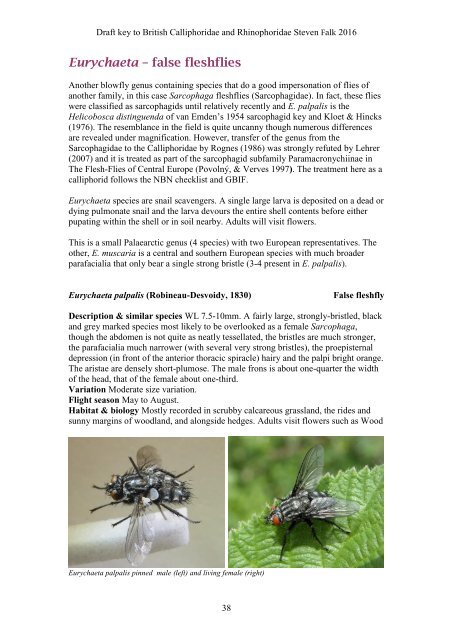BRITISH BLOWFLIES (CALLIPHORIDAE) AND WOODLOUSE FLIES (RHINOPHORIDAE)
4cmTmdCuA
4cmTmdCuA
Create successful ePaper yourself
Turn your PDF publications into a flip-book with our unique Google optimized e-Paper software.
Draft key to British Calliphoridae and Rhinophoridae Steven Falk 2016<br />
Eurychaeta – false fleshflies<br />
Another blowfly genus containing species that do a good impersonation of flies of<br />
another family, in this case Sarcophaga fleshflies (Sarcophagidae). In fact, these flies<br />
were classified as sarcophagids until relatively recently and E. palpalis is the<br />
Helicobosca distinguenda of van Emden’s 1954 sarcophagid key and Kloet & Hincks<br />
(1976). The resemblance in the field is quite uncanny though numerous differences<br />
are revealed under magnification. However, transfer of the genus from the<br />
Sarcophagidae to the Calliphoridae by Rognes (1986) was strongly refuted by Lehrer<br />
(2007) and it is treated as part of the sarcophagid subfamily Paramacronychiinae in<br />
The Flesh-Flies of Central Europe (Povolný, & Verves 1997). The treatment here as a<br />
calliphorid follows the NBN checklist and GBIF.<br />
Eurychaeta species are snail scavengers. A single large larva is deposited on a dead or<br />
dying pulmonate snail and the larva devours the entire shell contents before either<br />
pupating within the shell or in soil nearby. Adults will visit flowers.<br />
This is a small Palaearctic genus (4 species) with two European representatives. The<br />
other, E. muscaria is a central and southern European species with much broader<br />
parafacialia that only bear a single strong bristle (3-4 present in E. palpalis).<br />
Eurychaeta palpalis (Robineau-Desvoidy, 1830)<br />
False fleshfly<br />
Description & similar species WL 7.5-10mm. A fairly large, strongly-bristled, black<br />
and grey marked species most likely to be overlooked as a female Sarcophaga,<br />
though the abdomen is not quite as neatly tessellated, the bristles are much stronger,<br />
the parafacialia much narrower (with several very strong bristles), the proepisternal<br />
depression (in front of the anterior thoracic spiracle) hairy and the palpi bright orange.<br />
The aristae are densely short-plumose. The male frons is about one-quarter the width<br />
of the head, that of the female about one-third.<br />
Variation Moderate size variation.<br />
Flight season May to August.<br />
Habitat & biology Mostly recorded in scrubby calcareous grassland, the rides and<br />
sunny margins of woodland, and alongside hedges. Adults visit flowers such as Wood<br />
Eurychaeta palpalis pinned male (left) and living female (right)<br />
38


